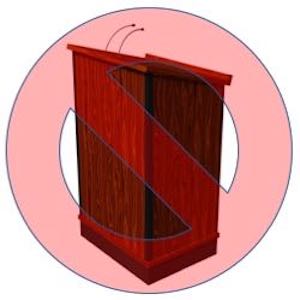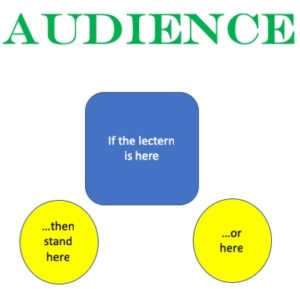By Dr. Ken Broda Bahm:

First, a pet peeve I just have to get off my chest: It is not called a “podium,” it is called a “lectern.” A podium is a platform that you stand on in order to be seen by an audience. And if you don’t believe me (because you have called that wooden thing speakers hide behind a “podium” all your life), then think of the Latin root. “Pod” means “foot,” as in “podiatrist.” A podium is something you stand on, a lectern is something you stand behind. Based on that Latin root (“lect,” or “read”), a lectern is something that you read from.
And standing on something in order to be seen, be it a stage or a soapbox, is a great idea. But standing behind a large structure so you can read from your notes, that is not as great. A lectern is a physical barrier, sometimes an absurdly large physical barrier between the speaker and the audience. It encourages the speaker to look at their notes, and it limits any movement and gestures that a speaker might have. In fact, if some evil genius were to design a tool in order to make speakers less dynamic and less interesting…that tool would look a lot like a lectern. That’s why I believe that in casual talks, CLE presentations, and even in court, if you can get away with avoiding the lectern, then you should avoid the lectern. In this post, I’ll share some reasons why, and also some best practices on what to do if you have to use that lectern.
Don’t Be Blocked
Part of what makes a speech interesting is the visual component. That is why we would rather watch a speaker than just listen, and that is why teleconferences can be such a chore to pay attention to. What the lectern does is put a physical barrier in front of the speaker so that instead of seeing the whole person, you are just seeing their head and maybe sometimes their hands. And in courtrooms with more extensive lecterns (for multimedia control purposes) it can be worse. Particularly for small-statured people (like myself), it can really diminish you as a speaker, literally, if most of your person is being blocked by a lectern.
Don’t Be Anchored
Nervous speakers often like lecterns, but not really for a good reason. They like lecterns because they want a protective barrier between themselves and the audience, and also because it solves the problem of movement. Not sure of how to move or how to use your hands? No problem, just stand behind the big wooden box and grip the sides with your hands. It can be more comfortable for those speakers who want to just hunker down and get through it. But for an audience, it is also less interesting. Speakers who want to engage their audiences will usually move around as they do so. That’s why you’ll never see a lectern at a TED talk. TED’s rules even prevent it. Misusing the word “podium,” they warn, “Speakers may not use a podium or lectern unless special circumstances warrant it. These objects disconnect the speaker from the audience, create an overly formal atmosphere, and encourage presenters to read from their notes (which is always boring to watch.)”
Don’t Over-Rely on Notes
A lectern really is a mini-desk for the speaker. By its placement, it begs you to use it as a focal point for your notes. So, if you really need your notes, then that can be a good thing. But, for important presentations and, I’d argue, nearly all presentations, it is better to go without notes. You do this by either memorizing (for formal presentations where every word is critical) or, more commonly, by speaking extemporaneously in a fashion so as to remember the content while naturally choosing the exact words as you speak. When you do that, you won’t need the notes. And if you have them in front of you anyway, even if it is with a “just in case” spirit, it may be too tempting and you may end up reading from them anyway. Avoiding the lectern solves that problem.
When You Have to, Use It as Little as Possible
Some judges will require you to use a lectern, and the physical arrangements at some conference presentations will encourage that as well. When you are forced into lectern use, then make sure you are using it as little as possible. Despite the presence of the “mini-desk,” use no more notes than you need, and ideally none. Even behind the lectern, you can move a bit, standing at one side or the other side of the lectern for different parts of the presentation. As long as the microphone situation allows it, it is best to stand at an angle and not directly behind the lectern so as to not block your body. Like so:

______
Other Posts on Physical Delivery:
- Improve Delivery By Perfecting Your ‘TED Moves’
- Speak Extemporaneously: Seven Tips for Losing the Notes Without Going Off-the-Cuff
- Go Ahead and Talk with Your Hands, But Know What You’re Saying